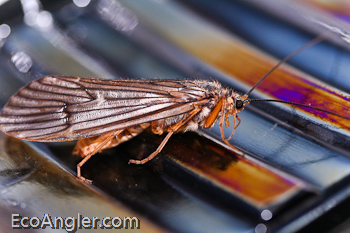What Fish Eat
Aquatic insects make up the majority of a fish's diet. The four key insect orders (listed first and not including Streamers or Terrestrials) that emerge from streams and lakes are:
The Gospel on Caddisflies

October Caddisflies

Some fishermen specialize in catching large trout... Anglers who want to catch such a trout on a dry or semidry fly need to know which aquatic insects can make fish in this size range begin feeding on the surface. ... The question for fly fishermen seeking big trout is: 'Which insects provide the best opportunity for catching such fish?' My list would be: Giant Orange Sedge, Salmon Fly, and the Michigan Mayfly (Hexagenia limbata). The Giant Orange Sedge is the most important--and the contest is not even close."
Caddisflies by Gary LaFontaine
According to Rick Hafele, Dicosmoecus larve spend a lot of their time on the tops of large cobbles in moderately fast water grazing on diatoms. As mid-summer approaches, larve congregate on rocks (or submerged branches) where they attach their cases and seal off both ends. The benefits of larval aggregations prior to pupation are not clear, but is common in a variety of caddisfly families.
Pupa to Adult Caddisfly
After several weeks attached to cobble or submerged branches, the larve leave their casing. Instead of emerging directly to the surface, these caddis swim along the stream bed until they reach large rocks which are partly exposed about water. During that time they are exposed to feeding trout. Once a suitable rock is found, the pupae crawl up the rock and the adults push out of the pupal shuck.
Hatches of October caddis can start in early September, but don't peak until mid September and then can run throughout October. The adult are active fliers in the late afternoon and evening as the females lay their eggs on the water's surface, in a fashion similar to bouncing up and down off the surface.
Photo of October Caddisfly by P. Michael Carl © The Ecological Angler

